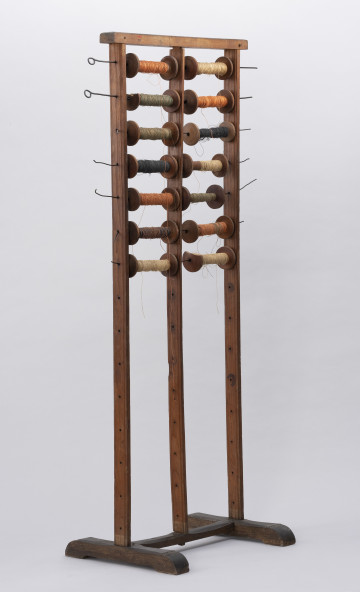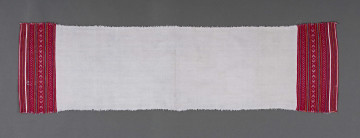
Weaving shuttle
1880 — 1920
National Museum in Szczecin
Part of the collection: Collection of Dogonian art
The traditional everyday dress of the Dogon man consists of tunic and trousers, usually white and brown. A goro hat completes it. Its most common form is a Phrygian cap, called ka gara or kelegu made of two square sheets of cotton fabric. It is worn variously, depending on the person’s region, age and function. In the Sangha village, it is worn ‘like a hunter’, ‘following western fashion’, ‘to shield the eyes from the wind’, ‘to shield the ears from the wind’, ‘like an old man’, ‘like a young man’ and ‘for mask dancing’.Boys wore the presented cotton cap to celebrate the most important festival of the Dogon called Sigi. It is an essential element of the costume worn by every male participant during the festival. The colour is crucial as it should be white to emphasise that this is a new Sigi festival. Men also wear numerous ornaments during the ceremony, including bracelets, bands, and necklaces, usually dedicated to women, who relinquish them to men on the occasion of Sigi.Sigi is the festival of rebirth. Every Dogon should experience it at least once in life, so the word Sigi can be interpreted as ‘to experience once in a lifetime’. The Dogon believe that those who have participated in Sigi can consider themselves reborn. The Sigi ceremony symbolises the death of the first ancestor. During the ceremony, a secret language Sigi-So (from the Mande group), is used. It is only spoken by initiated men who hold essential religious and social functions. The festival takes place once every 60 years. Its celebration begins in the villages of Youga-Dogorou, then moves from region to region, a process that lasts up to several years. The last Sigi began in 1966 and ended in 1974. The Dogon will celebrate the next festival, most probably in 2026.
Katarzyna Findlik-Gawron
Author / creator
Dimensions
cały obiekt: height: 27,5 cm, width: 35,5 cm
Object type
festiv costume
Creation time / dating
Creation / finding place
Identification number
Location / status

1880 — 1920
National Museum in Szczecin

1801 — 1939
National Museum in Szczecin

1900 — 1920
National Museum in Lublin
DISCOVER this TOPIC
National Museum in Lublin
DISCOVER this PATH
Educational path